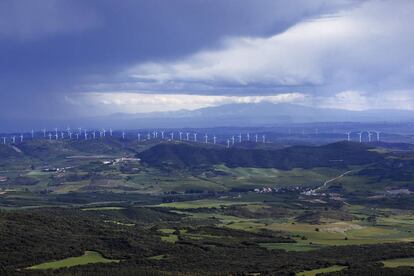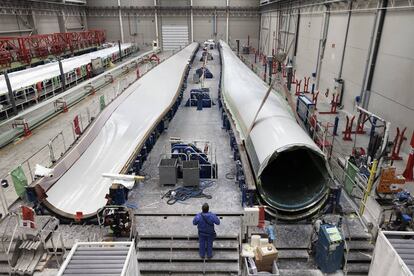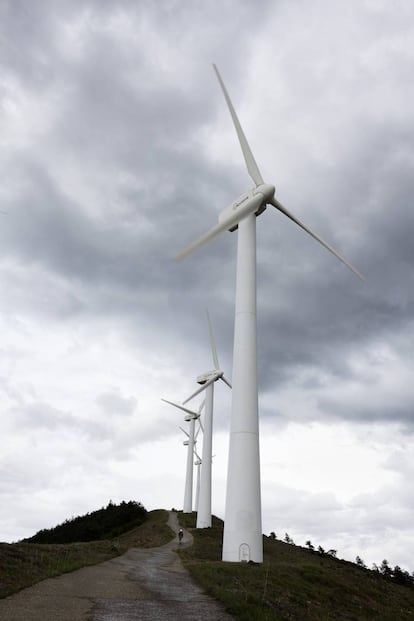Green energy: When Spain had the wind in its sails
The Perdón wind farm in Navarre is the birthplace of an industry in which Spain has played a pioneering role

A group of pilgrims on the Camino de Santiago climb up to the brow of the Perdón hills and take some pictures. To the north of them lies the city of Pamplona and its 200,000 inhabitants. To the south is the demarcation of Valdizarbe, with its villages scattered here and there across the countryside. It is a spring day, partly cloudy. The wind is so strong that it hurts your ears. It is blowing in from the south as though through a tunnel, and it makes the blades of the wind turbines turn at 30 revolutions per minute over our heads.
There are 40 windmills in total and each one is 40 meters high – the height of the Statue of Liberty. The blades measure 20 meters and the turbines are fashioned from 52.5 tons of steel and fiberglass. Each has a capacity of 500 kilowatts (kW). Every now and again you can hear them screech as you make your way past the substation to where it all began – the six first wind turbines that graced the Perdón hills.
These turbines began to generate electricity on December 18, 1994. In those days, they seemed enormous. “They were somewhat alarming,” says Javier Arcelus, 40, who came to see them as a teenager with his father, and who now manages all the wind farms in the area.
“Nobody expected it. Right here there was a tunnel of wind,” says one of the engineers who helped to set up the first wind farm in Navarre in the Perdón hills
Arcelus is stationed next to the visitor center where schoolchildren on field trips used to gather to learn about this clean source of energy. In those days, wind turbines were a novelty. Nowadays, the information panels are starting to rust, as if reflecting the sector’s decline in recent years. “Wind power is man taking advantage of the force of the wind,” says one sign. “The wind turbine is an advanced technological piece of machinery that generates electricity from wind,” says another.
These six wind turbines were not the first modern windmills to be put up in Spain. There were already 400 elsewhere, mostly in Tarifa, the Canary Islands and Galicia. Many were experimental, low-capacity models that were put up in places associated with wind.
During the 1990s, some believed that wind power could only be generated on the coast. But the landlocked Navarre, which was importing all its energy at that time, installed 21 meteorological stations. One of these was set up just meters from where the engineer Juan Otazu now recalls the excitement of that first wind adventure. “Nobody expected it. Right here there was a tunnel of wind,” he says. The wind was constant and not too turbulent, blowing at an average speed of 31.7 km/h.

Otazu, who is now 50, points out the village of Pitillas from the ridge. It’s where he was born and grew up. After school, he studied electrical engineering at the University of Navarre, which is when he heard about wind power for the first time. “It sounded crazy,” he remembers.
Denmark was already a pioneer in the field but Spain would soon catch up. When Otazu graduated, he was taken on by a Basque company named Ingeteam. The staff of six worked on automated processes of mini-hydraulic plants belonging to EHN (Navarre Hydraulic Energy). EHN, a public-private concern, had been created to encourage the renewable energy sector. It was they who set up the meteorological stations while Otazu’s company was in charge of their maintenance. When they discovered the tunnel of wind in the Perdón hills, the authorities gave them the green light. Otazu was responsible for designing the turbines’ connection to the electricity grid. He says the first time he saw a windmill, it was one of these, and he remembers thinking that it was the future.
He wasn’t wrong, either. Energy and industrial manufacturing outfits all wanted in on the action. Gamesa, a Basque air and space manufacturer, took charge of making the wind turbines in partnership with a Danish company called Vestas. Ingeteam, where Otazu worked, was tasked with translating the instruction manuals into Spanish. But soon they would dispense with foreign technology and Spanish companies would go it alone. It was boom time for wind, The Perdón wind farm grew from six to 40 windmills. In 1997, the biggest wind site in Europe was inaugurated next door. By 1998, EHN had nine wind farms in the region and wind was generating 20% of the energy in Navarre. In 2000, EHN won a Financial Times award for being the best international renewables company. Businesses kept pace with technology and multiplied.
In 2008, the wind sector employed more than 40,000 people in Spain. Today, after a five-year freeze on green energy, employment has fallen by half
Nowadays, Gamesa is a wind giant that has merged with Siemens, and is the world’s fourth-biggest producer of turbines; half the wind power in Spain is generated by them. Meanwhile, Ingeteam has grown to employ 3,700 people. And EHN was taken over by energy conglomerate Acciona in 2004 and is today the second-biggest wind operator in Spain after Iberdrola.
Its headquarters are Sarriguren, on the outskirts of Pamplona. The Ingeteam and Gamesa headquarters are next door, a stone’s throw from the Spanish Center for Renewable Energy (CENER), which is run by the central and regional governments. There are those who call this place the Silicon Valley of Wind, since this is where most Spanish patents related to wind have been filed from. It is a center of research and the engine of the wind industry in Spain.
Things have not gone badly for Juan Otazu either. He is now Acciona Energy’s head of production, managing 1,000 people and making sure that all the company’s global installations are operating as they should, whether they be wind-related, hydroelectric, thermal solar or photovoltaic solar. But Otazu has a soft spot for the sector’s origins. Gazing up at the first windmill, he says: “This is one of the most effective turbines in Spain.”

The wind turbine he is referring to was a leader both in Spain and in Europe and has already been in operation for 23 years, despite having a lifespan of just 20. Though old, it is one of the most profitable. “It made wind power competitive,” says Otazu. “Investment funds and banks don’t want to hear about nuclear energy or combined-cycle plants. This is the future.”
Many in the region are convinced that the success of wind power in Navarre is due to the turbines’ location. The Perdón windmills can be seen from Pamplona and have become an intrinsic part of the landscape. Initially, it was not unusual for locals to make day trips to see them up close. Gradually, an awareness was created. In Navarre, almost everyone knows someone who works or has worked in the wind sector, which employs 4,000 people here. And renewables cover 80% of demand. After 2005, however, deals for new wind turbines started to dry up, not just in Navarre but across Spain
Between 2004 and 2011, two-thirds of the current wind capacity was installed. Thanks to public money and premiums, Spain was at the top of the league regarding wind technology. But even those passionate about renewable energy recognize that a lot of the growth took place in a climate of speculation and haphazard development.
It doesn’t make sense that no one is using this industry to get us out of the crisis
Sergio Muruzábal, director of a turbine plant
In 2011, when Mariano Rajoy’s Popular Party took power, there was a freeze on green energy. In 2008, the industry employed more than 40,000 people. Today, it employs half that figure. While the most ambitious climate change agreement in history was being signed in Paris in 2015, wind power was entering its darkest hour in Spain. There was zero increase in capacity, allowing India to overtake and push Spain into fifth place –after China, America and Germany. And if in 2013 wind energy was the top form of generation technology in Spain, 2015 saw it take third place behind nuclear and coal. Recently, the sector has been on the move again thanks to new government auctions for renewable energy installation.
But the industry has survived and it has done so due to demand outside of Spain. Spanish companies exported 100% of their production in 2015, according to the latest report from the Spanish Wind Power Association. Spain is now the third-biggest exporter of wind turbines in the world, and its companies generate 10% of the world’s wind capacity.
Within the country, there are almost 200 factories producing the machinery. Pedro Campo manages a blade plant in Lumbier in Navarre, owned by Acciona Windpower-Nordex, the sixth-biggest turbine manufacturer in the world. The blades produced here measure 61.5 meters and weigh more than 15 tons. One is produced every 30 hours. “Like pretzels,” says Campo, an engineer from Navarre who first visited Perdón as a student. “It was incredible,” he recalls. “What would it lead to? Where would it take us? Many of those I studied with ended up in the sector. We wanted to get involved. It was a change from the traditional industry in Navarre, which was cars. This was different.”

The warehouse he showed us around was not unlike the workshop of a sculptor with an obsession for outsized objects. The process is very hands-on to the point of being almost artisan. There are operators wearing overalls, helmets and masks. There are rolls of fiberglass. There is a textile workshop where the fiberglass is cut, long worktops where the epoxy resin is applied. And tubular molds, where the plaster is arranged to form a shell that is covered by another shell, all strung together with girders until it becomes a blade that looks like the wing of a plane. Finally, it is sanded down, leaving a smooth cold finish that feels like steel. When it turns, the tip can reach 300km/h and has to withstand the most extreme weather conditions.
Not far from here are the CENER experimental wind farms. Having these ‘test labs’ handy gives the industry a competitive edge – there are, according to the experts here, only five installations like this in the world.
In the 1980s, the blades used to measure 12 meters. This morning they are testing 65-meter blades that could be fitted to turbines with a capacity six times as great as those in Perdón. Their length spans the breadth of a soccer pitch; turn it and it would sweep the pitch clean. Extreme weather conditions, such as hurricanes and typhoons, are simulated here with 150 prototypes undergoing tests that will allow them to be certified for commercial use.
One of the most frequent criticisms leveled against green energy is that surplus energy cannot be stored. “It is a lie,” says Monica Aguado, who holds a PhD in industrial engineering and lectures at Navarre University while also heading an experimental micro-grid that is being used to control the electricity supply to the CENER lab from sun and wind.
The experiment involves a warehouse with four storage systems – lithium-ion, flow, supercapacitors and lead-acid batteries. Depending on supply and demand, a model is designed to store and distribute energy. At times, a diesel engine is needed, Aguado confesses. But she insists that we could live 100% on renewable energy if storage was properly dimensioned. If it’s possible on this experimental island, it’s possible in the country as a whole. Perhaps so, but currently clean energy accounts for just 16.15% of total consumption in Spain. According to EU guidelines, this should reach 20% by 2020.
“It doesn’t make sense that no one is using this industry to get us out of the crisis,” says Sergio Muruzábal, director of the Barasoain turbine plant in Navarre where Acciona-Nordex assembles turbines and the pieces used to attach the blades.
An engineer from Navarre, Muruzábal is surrounded by enormous pieces of machinery, moved by cranes. He walks toward one of the finished turbines, which is the size of a bus and looks like a spacecraft, complete with a small hatch. Within, it looks like a primitive brain. A slow shaft turns at the speed of the blades, which is 20 revolutions per minute, a multiplier increases the rotation to 1,200 revolutions and another, faster shaft allows the generator to produce electricity at 12,000 volts.
Inside the capsule, there are components from all over the world, but many of them are Spanish and more specifically from Navarre, like the control system made by Ingeteam. Muruzábal also remembers when the first wind farm went up in Perdón. “I went to see it with my father,” he says. “I was 19 and starting university. I had no idea where it would lead. It was a strange feeling to be a technological pioneer; we usually associate that with other countries. This industry generates jobs and benefits society. We need to create a sustainable system with the future in mind. We have to make the system cheaper, but that is the case for all industries when they start out. Renewables exacts a lower cost in general when you take everything into account. I think there is a social awareness that is in favor of it. The future has to lie this way. And we have an advantage – we were the pioneers.”
The capsule is ready. Shortly, a truck will take it to the port of Bilbao. Final destination: Texas.
English version by Heather Galloway.


